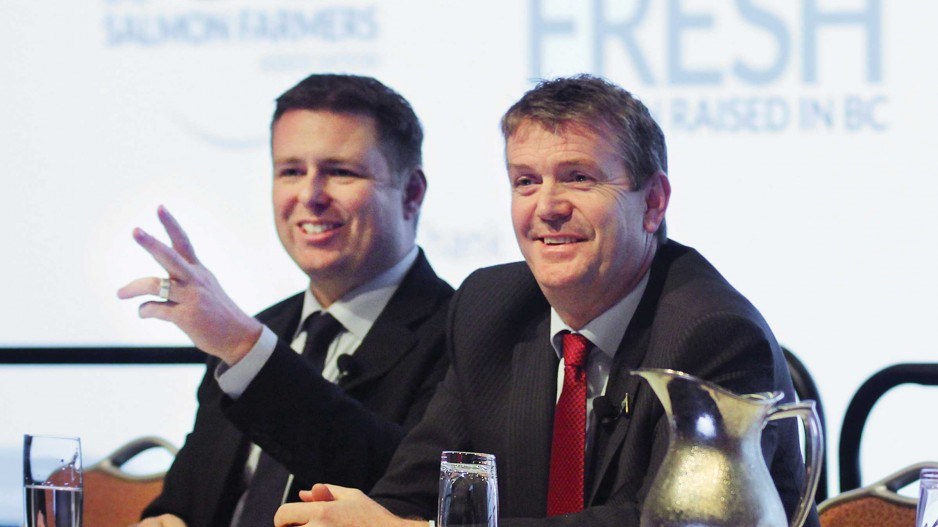Google “fish farms” and “B.C.” and the top-ranking website that comes up is farmedanddangerous.org from a coalition of environmental groups that includes the David Suzuki Foundation and T. Buck Suzuki Environmental Foundation.
For more than a decade, they have waged an effective public relations war against B.C.’s salmon farming industry, which they say is a threat to wild fish stocks.
While fish farming’s rap sheet for alleged environmental crimes is long, the biggest concern remains that farmed Atlantic salmon can spread sea lice, bacteria and viruses to wild Pacific salmon stocks.
In an attempt to address the concerns over fish farming, the BC Salmon Farmers Association (BCSFA) last week published its first sustainability report, and it has committed $1.5 million in funding over five years for new research, to be overseen by a 13-member science advisory panel headed by Don Noakes, a former director for the Pacific Biological Station.
“The funding is coming from industry but it’s going to independent researchers,” Noakes said.
BCSFA chairman Stewart Hawthorn said his association is “committed to developing a comprehensive program for monitoring sea lice on wild salmon near our farms so that we can, over time, identify trends and understand what’s going on in that wild-farmed interaction.”
Salmon farmers have also agreed to publicly reporting sea lice counts in their own fish farms.
“We’re committed to transparency around sea lice numbers on our farms, and we’re going to be, from this point on, making that information more available to the public through each company publishing sea lice data every month,” Hawthorn said.
Alexandra Morton, an independent biologist who has been one of the most vocal critics of fish farming in B.C., calls the BCSFA sustainability report “window dressing.”
“Counting lice is nice, but this spring the industry lost control of their lice, once again after seven years of successful louse control,” she said in an emailed statement. “A significant proportion of young wild chum and pink salmon were killed by those lice, based on the science done in B.C. that demonstrated how many lice it takes to kill our salmon.”
There are roughly 60 fish farms in operation at any given time in B.C., most of them raising Atlantic salmon. The industry is worth $1 billion to the provincial economy, according to BCSFA executive director Jeremy Dunn.
“Farm-raised salmon, quietly, has become B.C.’s No. 1 agricultural export,” Dunn said, adding that farmed fish represents 60% of B.C.’s total seafood exports.
Farmed salmon are raised in netted pens in sheltered bays and inlets along the coast, and, because the pens are so crowded, disease can easily spread among the farmed populations.
The industry uses antibiotics and vaccinations to control disease. Despite attempts to reduce the use of these drugs, B.C. fish farms have the second-highest use of antibiotics of all the fish farming nations, just behind Chile, according to the BCSFA’s own report.
“We want to focus on reducing antibiotic use on our farms … the goal being to not use antibiotics at all,” Hawthorn said.
Another concern with fish farms is the use of the antifouling coatings on fish pen nets to reduce the buildup of algae. Because the copper-based compounds used are toxic, the industry has committed to phasing them out.
One area that the industry has made strides on in recent years is the ratio of fish protein used in fish feed. In the past, it took about four to five kilograms of fish protein to raise one kilogram of salmon. Much of that protein came from wild fish stocks, such as herring and anchovies.
The industry has worked to reduce the amount of fish protein in fish feed to just 18%, with the balance made up from plant products and other non-marine protein sources.
“We’re now really proud to be net producers of marine protein,” Hawthorn said.
One conservation organization that supports fish farming – if conducted sustainably – is the World Wildlife Fund (WWF).
Compared with other protein sources such as beef, chicken and pork, fish farming has the smallest environmental footprint in terms of energy and water use, and feed conversion ratios, according to the WWF.
But other environmental groups insist that the only environmentally responsible way to produce farmed fish is by raising them in land-based tanks.
Bill Wareham, science projects manager, western region, for the David Suzuki Foundation, said the commitment to report on sea lice counts is encouraging, but he hopes the industry also shares what kind of treatments they are using and other related data.
“It’s a partial step but it doesn’t go far enough to meet our requirements for total data transparency,” Wareham said.
He said it’s also encouraging that the industry is pursuing Aquaculture Stewardship Council certification for some farms. But he said a lot more science needs to be done on the relationship between wild and farmed salmon.
“Until the science is more definitive, you can’t say that everything’s fine, because other parts of the world – whether it’s Scotland or Norway or Chile – we’re seeing continued surprises in the disease realm when it comes to farmed salmon.”




